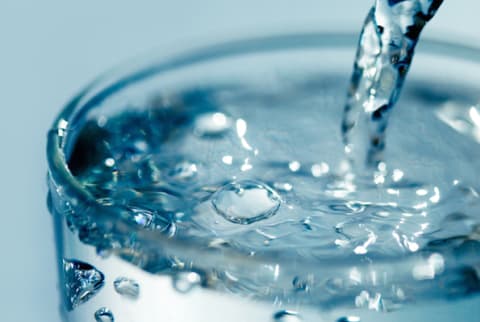Advertisement


“Drink more water” is not the sexiest of wellness manifestos. For many people it falls under the category of common sense. Yet many experts site chronic dehydration as one of the biggest barriers to good health — and it also happens to be one of the easiest and cheapest to fix.
Unfortunately though, not all water is created equal.
I wised up when I started seeing a naturopath and she was flabbergasted when I told her I didn’t filter my water and rarely, if ever, drank any H2O that didn’t come from the tap. I’m that dork who always tells the waiter a bottle of New York’s finest, please in an attempt to be charming.
My doctor whipped me into water shape and told me I’d never be able to control my hyperthyroidism while ingesting so much chlorine, fluoride, and other chemicals in the city’s tap water. This sent me on a wild goose chase trying to find a water filter that could fit within the confines of my small kitchen, and not require hundreds of dollars and a plumber to install.
In the process of trying to drink cleaner water, I also learned a lot about healthier ways to hydrate to ensure that your body absorbs water properly, without introducing a bunch of other toxins with every sip.
Here are some strategies I developed for drinking better, cleaner water and more of it.
1. Ban the beverage aisle.
There’s perhaps no better space to witness how the wellness industry has grown over the last few years than the beverage aisle. A lot of these drinks aren’t as good for you as the label claims. More importantly, no matter how many electrolytes or probiotics your bottle actually has in it, as far as hydration goes, no drink is better for you than water. And it’s free!
Putting yourself on a brief beverage aisle ban can help you get back in the habit of making water your drink of choice. When you’re used to chugging things that are sweet, it makes drinking more water a real uphill battle. No glass of H2O will ever compare to a Hibiscus kombucha tea.
The ban will also break your dependency on bottled water, which is even less regulated than tap. Despite marketing claims, your bottled bottle is more likely to be sourced from a man-made well in Queens than a glacier in Alaska. You’re paying a premium for that bottle, which also leaches plastic into your agua and pollutes the environment after it’s thrown away, with no real health benefits.
2. Drink your body weight in ounces.
The general rule of thumb to stay hydrated is to drink half your body weight in ounces daily — and even more if you live in a dry place or exercise a lot. You can also take cues from your pee and drink until it’s a nice clear mellow yellow. I like using the app Moro when I’m on the go to track my intake. But if you’re at home or the office, you can just measure with a designated water receptacle (see below).
3. Put a pitcher or water bottle on your desk.
Having a designated water bottle or pitcher, not only helps you measure your daily intake, but it also is a powerful physical reminder to drink. Don’t underestimate what having a bottle physically in front of you will do for your hydration. If you don’t want to count bottles, you can get a pitcher that holds your exact body weight in ounces. This is a more fun strategy for getting add-ins involved like flavored ice cubes or sliced lemon.
4. Avoid guzzling during meals to maximize absorption.
One key tip for maximizing absorption and retention is to avoid drinking water at meals. You’re supposed to stop 30 minutes before eating and wait an hour after until consuming more. I’ve tried this, and it’s a struggle. Especially when you accidentally eat the ghost pepper in your Thai curry. But it will also help with digestion. Water dilutes your saliva’s natural enzymes that help break down food and has a similar effect when it reaches your other digestive organs.
5. Invest in an at-home filtration system.
Sadly, the regulations on our tap water are incredibly outdated. The list of chemicals that are banned in drinking water has not been majorly updated since the 1980s, which means rocket fuel additives and dry cleaning solvent can still legally flow from our tap under The Clean Water Act.
Home filters are better for your wallet, and better for the planet. But finding the right one can be tricky. Unfortunately, anything that’s cheap, space-efficient and easy to use, like your standard Brita, does not do an effective job at filtering most of the offenders. Pitcher filters also require you to buy new cartridges every few months, which can add up. Still, they are a good place to start.
Soma makes a great plant-based carafe filter (a creative spin on the usual pitcher), and New Wave Enviro has a relatively affordable countertop unit that hooks up to your sink.
6. Remove water toxins on the go.
Drinking filtered water when you’re traveling is a lot more difficult than making a concerted effort at home. Japanese charcoal sticks are the best cheap on-the-go filter. These porous sticks look like something you pulled from a campfire, but they are shockingly adept at absorbing impurities. The only catch is you need to let the charcoal do its thing for an hour or so to get the best results. They also need to be “refreshed” every few weeks, which involves simply boiling them for 10 minutes. You’ll want to replace them completely every 3 months, which is roughly the same time frame as a pitcher filter cartridge.
In fact, most Britta filters and comparable models use granulated charcoal, hence why you sometimes see little black bits in the bottom of your cup when the filter is on its last legs. Having the whole block carbon charcoal stick is a much more effective way to catch toxins, and you can pack them in your carry on!
7. Make your showers safer.
While not directly related to hydration, you spend a lot of intimate time with water everyday in the shower. I also got a filter for my showerhead after I heard that your skin can absorb up to 8 glasses worth of toxins during the average rinse. It seems silly to spend so much time and money obsessing over the water you drink, if you’re just going to be absorbing a comparable amount of chemicals through your skin.
It’s also worth investing in a canvas natural shower curtain. Believe it or not, your shower curtain is one of the most toxic things in your home! The liner is usually made of BPA plastic, which means you’re hot boxing your bathroom with chemicals. A warning though: you will have to wash fabric curtains often if you don’t want them to become tie-dyed with mildew. I felt that this downside was worth it in the end.
A final word:
Try to remember that as scary as some of this water stuff might be, it’s important not to live in fear! Drinking impure water is better than drinking no water at all. Your liver was designed to be your own personal water filter and make sure toxins are eliminated properly. But none of your organs can properly function without water. When in doubt, relax and take a sip.
The Wellness Project is a year-long blog series (and upcoming memoir) about how to find the balance between health and hedonism. To find out more about the inspiration behind the project and to get the monthly theme schedule, click here. For the list of upcoming experiments, see my article 12 Monthly Wellness Challenges For the Year Ahead on MindBodyGreen and follow along!

Phoebe Lapine is a food and health writer, chef, speaker, and the voice behind the award-winning blog Feed Me Phoebe. She is the author of 4 books, including the forthcoming Carbivore, and her debut memoir, The Wellness Project, which was named by Women’s Health Magazine as the top nutrition read of 2017. An advocate for autoimmune disease and finding food freedom despite chronic illness, Phoebe’s work has appeared in Food & Wine, Marie Claire, SELF, Glamour, Cosmopolitan and Mind Body Green, who named her one of 100 Women to Watch in Wellness. She lives in Brooklyn with her husband and daughter.
More from the author:
How To Make Healthy & Delicious Meals
Check out Learn How To Stock A Healthy Pantry & Meal Prep Like A Pro While Also Saving Time & Money
More from the author:
How To Make Healthy & Delicious Meals
Check out Learn How To Stock A Healthy Pantry & Meal Prep Like A Pro While Also Saving Time & Money

Phoebe Lapine is a food and health writer, chef, speaker, and the voice behind the award-winning blog Feed Me Phoebe. She is the author of 4 books, including the forthcoming Carbivore, and her debut memoir, The Wellness Project, which was named by Women’s Health Magazine as the top nutrition read of 2017. An advocate for autoimmune disease and finding food freedom despite chronic illness, Phoebe’s work has appeared in Food & Wine, Marie Claire, SELF, Glamour, Cosmopolitan and Mind Body Green, who named her one of 100 Women to Watch in Wellness. She lives in Brooklyn with her husband and daughter.
Watch Next
Enjoy some of our favorite clips from classes
Enjoy some of our favorite clips from classes
What Is Meditation?
Mindfulness/Spirituality | Light Watkins
Box Breathing
Mindfulness/Spirituality | Gwen Dittmar
What Breathwork Can Address
Mindfulness/Spirituality | Gwen Dittmar
The 8 Limbs of Yoga - What is Asana?
Yoga | Caley Alyssa
Two Standing Postures to Open Up Tight Hips
Yoga | Caley Alyssa
How Plants Can Optimize Athletic Performance
Nutrition | Rich Roll
What to Eat Before a Workout
Nutrition | Rich Roll
How Ayurveda Helps Us Navigate Modern Life
Nutrition | Sahara Rose
Messages About Love & Relationships
Love & Relationships | Esther Perel
Love Languages
Love & Relationships | Esther Perel

















